26
Keep Calm and Carry One: The Civilian Gas Mask Case and its Containment of British Emotions
Mats Fridlund

Fig. 26.1 General civilian anti-gas respirator carrying case with British civilian gas mask (copyright Imperial War Museum, London (EQU 2706))
Box: general civilian anti-gas respirator carrying case. Size and shape: 17 cm x 13 cm x 11 cm rectangular cardboard box with two flaps under main lid and a string strap filled with a gas mask of small, medium or large size. Colour: brown. Behaviour: containing, protecting, swinging from shoulders or on hangers in homes or workplaces, rarely opened, never activated but always present. Habitat: throughout the United Kingdom. Distribution: spotted in big British cities and especially in London; some 50 million during its active phase. Migration: during the Second World War many travelled from public places to private homes and into dark closets. Status: currently more or less extinct except for some remaining specimens in museums, at flea markets, and on eBay.
Keywords: comforting, protecting, carrying, threatening, mobilising, signalling, awakening, frightening, waiting, simulating, practising, training
By 4 September 1939, the day after the outbreak of the Second World War, millions of brown boxes had already transformed London. ‘That Monday morning, everywhere you went people were carrying their masks. It was almost like an army with those brown cardboard boxes over their arms’ (Haining 1989). At the war’s outset three out of four Londoners were estimated to be carrying one, and the public box-carrying was encouraged by example, with members of the government and the Royal Family ‘liberally photographed carrying these’ (Haining 1989: 60; Mass-Observation 1940: 111). A few weeks later a woman was given ‘a full realization of the effect of the war’ upon arriving at Waterloo Station and seeing ‘sober, respectable businessmen walking about solemnly with cardboard boxes strung around their necks’. According to the government-contracted social research organisation Mass-Observation (M-O), the ‘masses’ were to be ‘helped to feel that if this was a new kind of war, it was their war too. The gas mask was, for a time, the best of any propaganda to uplift civilian morale. It gave the led a feeling of equality with their leaders, a participation between the YOU and the US, the civilian and the soldier. Everybody was armed. For a time’ (Garfield 2005: 40; Mass-Observation 1940: 111).
British civilians had been armed with gas-mask-loaded cardboard boxes due to a widespread fear of a future war that could end civilisation through aerial gas bombings. To discipline citizens’ fear, the government had in 1936 announced that ‘a simple but effective form of respirator for use by the civil population’ was in the works, and that this gas mask should be provided freely if the need should arise. This was a new government obligation ‘since in no previous war had a Government had to contemplate the possible death or injury of so large a proportion of the civil population, by one weapon’ (Titmuss 1950: 21; O’Brien 1955: 70, 77). In January 1937, British cinema audiences had been shown news reels proclaiming that the government’s first gas mask factory in Blackburn would be turning out half a million gas masks a week (Aldgate 1979: 143–144, 152). The civilian gas mask thus became an iconic materiality of wartime fear, and the most widely distributed everyday commodity for helping citizens cope with the future air war (Fritzsche 1992: 214–15; Fritzsche 1993: 698).
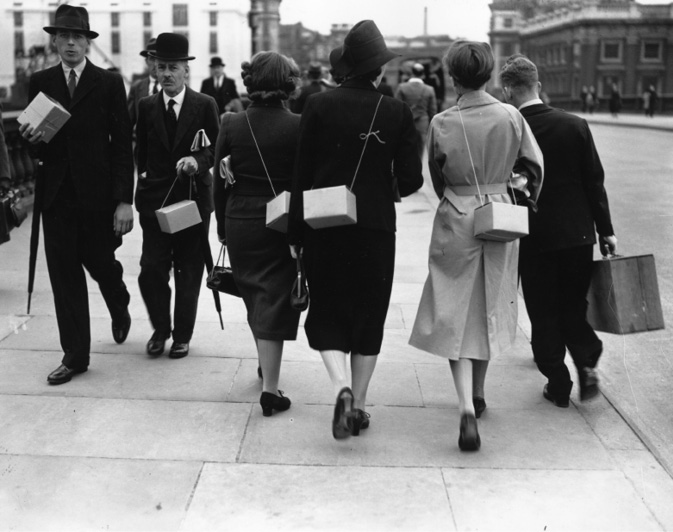
Fig. 26.2 Civilians walking on the streets of London with gas mask cases after the outbreak of the Second World War (photo by Reg Speller/Hulton Archive/Getty Images)
Forgotten Feelings out of the Box
The gas mask’s wider introduction came with the Munich crisis in 1938 when the British Prime Minister Neville Chamberlain visited Hitler three times to resolve the threatening Sudeten issue, which was solved in Germany’s favour. Many British citizens got ‘their first visible, personal proof of the threat which overhung them’ when, during Chamberlain’s second visit on 24 September, the Home Office asked local authorities to start distributing respirators to the public (O’Brien 1955: 157). Recollections of the gas mask case’s sudden emergence in September 1938 make clear that it was not just an inanimate thing or a silent symbol of a possible war. The mundane case and its masked content were entangled with complex feelings of fear of death and hopes for survival, and inculcated immediate and new sensations and emotions. War – to one person at least – from
being a remote possibility, became almost overnight an immediate danger. I can remember at my boarding school, where the wireless was banned and interest in politics discouraged, how suddenly one evening, soon after the start of the Christmas term, the lights began to dim in a trial black-out, and how, when they were raised again, the staff hurried in with armfuls of small cardboard boxes and one by one we were outfitted with a gas mask. This was what brought home to most people the real meaning of the crisis. (Longmate 1971: 2)
Similar close encounters with the small cardboard boxes generated new, previously unknown and visceral emotions. One woman described how the boxes even produced a numbing physical fear:
as I looked through the lounge doors, I saw a sight which frightened me. The whole family and all the guests were standing in the lounge, on the table there were a lot of square boxes marked “Small” “Medium” and “Large”. Each contained a gas mask. A man was fitting my mother, he asked her to breathe and he held a piece of paper against the end of the hideous contraption. Is it really as bad as all that? […] After I had my mask fitted I returned with you [her fiancé] to our sitting room. You kissed me but I felt too frightened to notice. (IWML, Hurford-Veazey)
But it is too easy and not correct to state that the cardboard boxes just made people ‘realise’ or ‘awoke’ them to the actual threat of a coming war. It is true that the fear and sensations of future war the cardboard cases created shared aspects and affects of the actual war that materialised, but it was also something radically different. Although that which was feared – indiscriminate gas attacks upon the British civilian population – was not realised, the fear was very real; it was imagined, embodied and experienced, contained inside people’s bodies and minds despite not materialising outside. The Second World War both wasn’t and was the gas mask cases’ war. It wasn’t, as the war saw no gas bombings, and yet it also was, because the possibility of gas attacks was kept alive throughout the war in the form of mental visions, public practices, visceral sensations, and material things stowed away in minds, representations, bodies, and closets. What follows is a history of the ‘subject politics of technology,’ focusing more on material things’ ‘experiential effects on human subjects rather than the symbolic discursive meanings of technological objects’ (Fridlund 2011: 392). This history seeks to recover a forgotten and fear-filled past by unpacking the tensions between fear of death and hopes for survival contained in the mundane cardboard boxes.
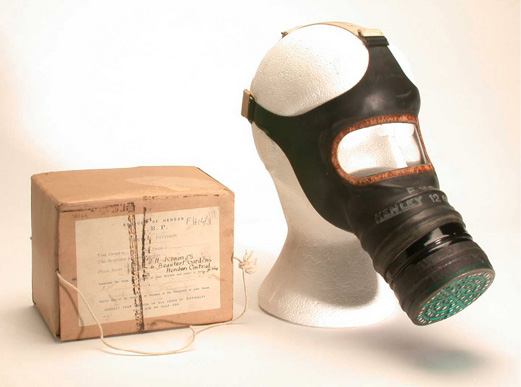
Fig. 26.3 The British civilian gas mask and officially issued cardboard gas mask case, with cord for carrying (courtesy of Islington Education Library Service)
Always Carry One
Immediately after the Munich crisis had ended in Germany’s favour, the government booklet The Protection of Your Home Against Air Raids was delivered to every British home, to prepare the people of Britain for what to do if this country were ever at war’. The booklet contained an official description of the contents of the thirty-five million cardboard boxes that had been issued: the ordinary citizen’s mask. It was ‘designed for you by Government experts’, came in three sizes and consisted ‘of a rubber facepiece with a transparent window, and a container which holds the gas filters’, of which one ‘consists of specially prepared charcoal, and the other of pads of specially prepared material’. The mask, if
properly put on, protects the eyes, nose, mouth and lungs; and it ensures a supply of pure air for breathing, by means of filters which are able to absorb any gas known to be capable of being used in war. The facepiece, the edges of which fit closely round the face, prevents any air from getting inside the respirator except that which passes through the filters. It is held in position by adjustable straps behind the head. Once these straps have been properly adjusted, the respirator, if needed, can be put on instantly (Home Office 1938: 7).
The booklet prefigured the future war by exhorting its readers to think things through, to prepare, and then to ‘see how to apply them [the instructions contained in the booklet] to your own home’. It also admonished the public to ‘always carry a respirator with you throughout the war’, as there would be a ‘limited number’ of public refuges for ‘those caught in the streets’ (Home Office 1938: 28). Less than a year later, the war was no longer in the future.
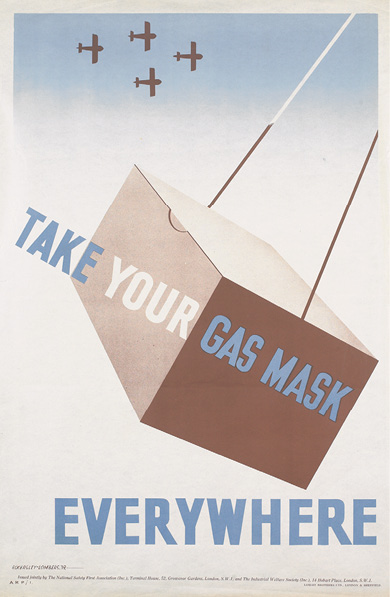
Fig. 26.4 Carry one everywhere. Poster by Thomas Eckersley and Eric Lombers, 1939. (Reproduced by kind permission of the Royal Society for the Prevention of Accidents and Imperial War Museum, London (Art. IWM PST 13860))
On 1 September 1939 Germany attacked Poland. The British government immediately issued an ultimatum for German withdrawal, and began readying and issuing some fifty million civilian gas masks (O’Brien 1955: 231). The Londoner Valerie Reid’s diary (IWML, Reid) makes visible the emotional effects connected to this. On that same day, she had been visiting various offices in a vain attempt to sign up for volunteer work:
Outside in the hot street the sun shines. Now what? A gas mask. I had better go and get one. Lisson Grove they had said. […] It was not easy to find your way about the big supply station. Ambulances and lorries encumbered the yard. Men in the uniform of decontamination squads were busy under the open sheds. “TO GAS MASKS” read the clumsily printed notice with an arrow pointing up an iron fire escape staircase. “TO GAS MASKS” said another scrawled in blue pencil on an open door. “TO GAS MASKS” […] but here the crowd made further indications unnecessary. By this time I was both hungry and thirsty. Slowly, so slowly we moved forward. A large room at last arranged like a concert hall with chairs in rows down the middle and round the sides. On a small raised platform at the end two men in shirt sleeves were working doggedly persistently. They both looked dead tired, their movements automatic and careful as if they had no energy to spare for any false move. I looked at them to the waiting crowds. Here surely was work, the something I could do. No longer tired and in spite of scowls I pushed my way to the front. “Do you want any help?” I asked the man in the pink shirt. He was adjusting a head strap and without looking up his reply came, “My god, yes. This is how you do it”.
Two days later, immediately before the war’s outbreak, Reid returned to issue masks and cases under the supervision of ‘Cap’:
We were short of cases and an order came through forbidding us to issue any more except with masks. A very old woman came in and talked to Cap after a minute or two. He beckoned to me. “Here, deal with this will you,” and turned away to talk with a group of storekeepers. The old woman had come a long way. She and her husband wanted cases; they felt there was more protection with a case. Her rheumy eyes were anxious and tearful. “But I can’t come again tomorrow. It’s the fares dearie. My old man ‘e’s that upset with it all and him not able to get about like […]. Besides they’re better in a case, safer like […].” Cap looked across as I handed her the precious cases, his left eyelid dropped imperceptibly as he turned his shoulder to this breach of official regulations.
When the British ultimatum generated no response, Chamberlain, at 11.15 am on 3 September declared in a short radio announcement that ‘this country is at war with Germany’. Thirteen minutes later, the first air-raid siren went off in London. Although a false alarm, its responses demonstrate the existing gas fear. Many Londoners were conditioned by their previous indirect experience of gas war. One woman reported that her grandfather,
a badly gassed veteran of the first world war, said “this is it, we’re in for it this time and we’re not ready”. The siren sounded the first air raid of the war and we thought that Grandad was right. … We sat around and then suddenly Grandma said “Where are your gas masks?” In our hurry to leave home we had completely forgotten about our little cardboard boxes. With visions of our being gassed Grandma hastily produced large pads of wet flannel that we were to hold over our nose and mouth. We then departed from Islington very quickly to get away from vulnerable London and motored through Oxford Street heading west with our wet pads at the ready waiting for the first gas warning. With great relief we heard the “All Clear”. We never went without our cardboard boxes for a very long time after that. (IWML, BBC Radio, Payne)
Domestication and Naturalisation
The fear of coming gas attacks was soon domesticated. Already on 13 September a London woman wrote that the ‘little cardboard boxes which contain our gasmasks are slowly losing their “sameness” as the most fantastic and colourful covers are appearing everywhere. It doesn’t take a woman long to ornament even that nasty little necessity!’ (IWML, Hall). Many brown cardboard cases were replaced by colourful commercial variants in cloth, leather, or metal, and in 1940 it was reported that the most popular ‘female carrying colours’ for containers were brown, white, cream, and green (Mass Observation 1940: 114, 117). As the war continued, many volunteer women felt that ‘anything that smacked of frivolity and femininity’ after a long day in uniform became ‘morale boosting’. The morale of some was raised by ‘Elizabeth Arden’s velvet-covered gas mask cases which had their little silk-lined pocket for cosmetics on top’. Furthermore, many old and new domesticated cases didn’t actually contain masks anymore, but instead lunch sandwiches, make-up, and other personal belongings (Courcey 2005: 123).
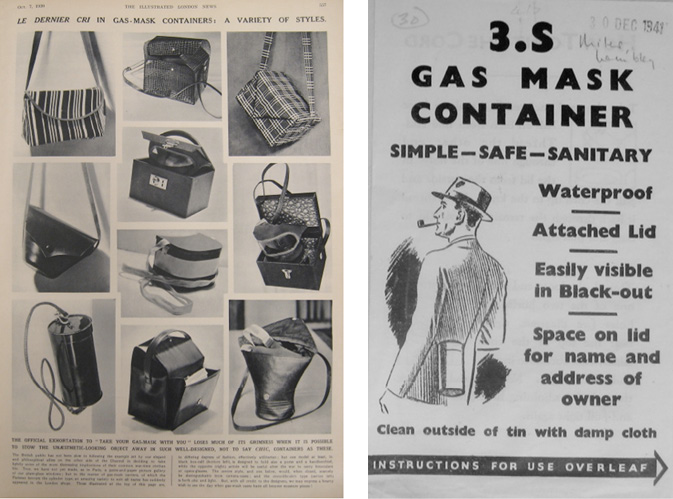
Figs. 26.5a, 26.5b Gendering the fear of gas. The Illustrated London News 7 October 1939 issue showing the ‘chic’ ladies fashion in gas mask cases, together with an advertising leaflet directed at male carriers for the 3.S (‘simple – safe – sanitary’) gas mask container (sources: Fig. 26.5a, Illustrated London News (1939); Fig. 26.5b, Mass Observation Archive)
The practice of carrying gas mask boxes changed fast. A London park-keeper noted on 6 October: ‘Crowds of shoppers at Woolwich. Life is normal again. Many people do not carry their gas masks. Some, I am sure, imagine that this is all they will know of war, and have become bold again’ (Mass Observation 1940: 117). In some cases, people were even chided for carrying masks. A Glasgow office worker reported that ‘the office girl, has had many raggings in the past because of her attachment to her gas-mask, with the result that she has been ridiculed into leaving it behind in the office when she goes out for a message. She asked me (a confirmed gas-mask carrier) whether or not she should take it, and I said I would in her place’ (Garfield 2005: 61). By November, many British apparently saw one of the ‘main inconveniences of war-time on the home front’ as ‘having to carry gasmasks everywhere, especially in crowds’, this being, at any rate, one of the ‘most often’ heard ‘grouses’. One exemplary quote: ‘Will the day ever come when we can go without these?’ (MOA, SxMOA1/3/37).
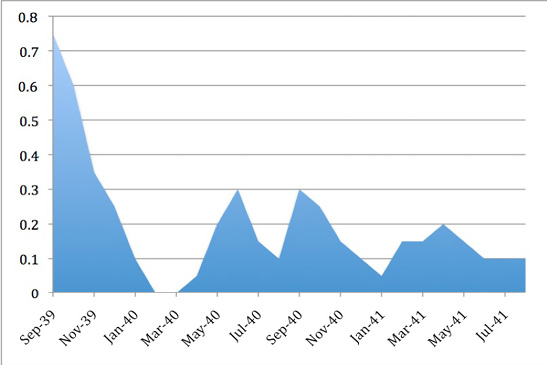
Fig. 26.6 Gas mask box counts in London by Mass Observation (data from Field Report 1666, Mass Observation Archive)
By Spring 1940, gas mask carrying was so rare that M-O, which counted conspicuous carriage of gas mask boxes as an indicator of civilian morale, and reported on it to the government, started to measure adherence to protocol in actual cases instead of percentages. The gas mask’s disappearance was described as one ‘important outward symbol of “unity” that has gone by the board. One factor in this dwindling is the dwindling of fear’. M-O warned that ‘the immediate attack that was foreseen did not occur, but there is no telling when it may occur. When that time comes, it will be more difficult to attain 100% mask-carrying than if the percentage had been kept at a steadily high level by suitable stimulation’ (Mass-Observation 1940: 116–117). However, the gas threat was still a reality to many. The day before the start of the Blitz, a couple wrote to American friends that although their masks were unused, ‘we must be prepared, and not just think they never will be wanted’ (IWML, Shean).
Complicating Case Studies
The gas mask began to appear again when the war entered a new phase with the German invasion of Denmark and Norway in April 1940 (O’Brien 1955: 366). M-O noted another spike with the invasion of Holland and Belgium in May, and another when the Blitz began in September (MOA, SxMOA1/2/55/2/L/3).
By 1941 Mass Observation’s initial notion that gas mask carrying had a positive association to general morale had changed. There was a ‘definite’ association, but it was ‘complicated’ (MOA, SxMOA1/1/6/5/21). Now carriers were read as indicating fear, and abstainers as indicating fearlessness. Carrying tended ‘to be associated with anxiety’ and ‘to go up in times of crisis, even though there is no immediate home threat’ (MOA, SxMOA1/1/6/9/13). Admittedly there were also those like Dr P. E. Vernon, Director of Psychology at Glasgow University, whose research indicated that gas mask carrying mainly ‘goes with support for the Government and optimistic opinions’, and primarily depended ‘on being a good citizen and doing what the government says without criticism’ (MOA, SxMOA1/1/6/6/18; SxMOA1/1/6/11/1). However, several indicators showed the problems with using gas mask cases as an indicator of morale. One was that a number of people who did not carry masks appeared ‘to possess 2 and even 3 gas masks which they keep at home and office, to save carrying up and down’ (MOA, SxMOA1/2/55/1/B/3). Furthermore, it was also evident that there was ‘no evidence at all’ that mask carrying correlated with gas expectations, as those who did not believe that gas would be used ‘carry their masks as much as the others’ (emphasis in the original). This produced the somewhat puzzling result that in addition to those generally worried about gas, many of those carrying masks had no confidence in the masks or no expectations that gas would be used. It appears as if the de facto situation was more about emotions than anything else. It seems ‘possible that those who regularly carry their masks may tend to do so without particular logical reference to the actual value of the gasmask as a method of protection against gas – i.e., they use it as a sort of psychological weapon’ (MOA, SxMOA1/2/55/2/C/1).
During the spring of 1941, government gas mask propaganda intensified. In March the Minister of Home Security gave a radio talk telling people to carry their gas masks regularly, and this was followed in April by the production of the leaflet What to Do about Gas, estimated to have been seen by some sixty percent of Londoners, and which was apparently responsible for a temporary increase in gas-mask carrying (MOA, SxMOA1/1/6/5/2). The threat and fear of gas was still alive. M-O, which had interviewed Londoners about their attitudes to gas, concluded a ‘general trend’ ‘for more people to expect gas than not to expect it’, with almost half believing that gas was going to be used. More than ten percent ‘had little faith’ in the efficiency of their masks, with one respondent believing the mask’s value to be ‘psychological only, it would prevent panic and people would die quieter, which is all that interests the Government’ (MOA, SxMOA1/2/55/1/B/3).
Packing up and Unpacking
Gas-mask use waned in 1941 when Germany opened up a second front in the Soviet Union in June and the USA entered the war in December (Bell 2009: 158). Following the invasion of the Soviet Union, mask carrying went down to about 10 percent, which led to a new Ministry of Home Security campaign with 400,000 posters encouraging gas-mask use. It had little effect. People asked about it approved, although some saw it as ‘silly sensation-mongering’ and others as ‘not startling enough’. The main problem was seen as an excessive saturation of ‘gas propaganda’, as a result of which most people had already ‘mainly made up their minds or reached boredom point about gas’; furthermore many who believed that gas would come still did ‘not believe in their gas-mask’. In addition, there was the ‘deeper’ problem that many people did ‘not want to think about gas at all’. Nevertheless, the campaign was still seen as valuable because, in the long-term, it ‘undoubtedly keeps gas as an idea alive in the public mind, and keeps people more conscious of their gas-mask, even if they do not carry it’ (MOA, SxMOA1/1/6/7/31; MOA, SxMOA1/1/6/8/6).
After the summer the bombings receded but the fear remained. The domestication of the gas threat in 1942 took somewhat of a turn towards entertainment and spectacle with the arrangement of local ‘Poison Gas Weeks’. One of these, held in Richmond on 15–20 June 1942, featured shop windows ‘literally plastered with yellow notices’ warning that there ‘will be surprise poison gas attacks’ and that there ‘will have to be A FIRST TIME. Carry your gas mask!!’. Wall posters screamed: ‘POISON GAS WEEK. FACE IT WITH YOUR MASK’ and ‘IT’S IN THE AIR POISON GAS WEEK’. A slogan competition had been won by an anonymous submission, ‘Gas? Mask it!’, with second prize to a 9-year-old girl: ‘“PRIVATE” Gas Mask your own “HOME GUARD”’. An observer was told by the Week’s publicity manager that ‘In the event of a Tear Gas Raid, people are expected to move freely and to continue with their shopping – if this occurs then Richmond will have created a precedent’. All shop keepers participated by carrying notices, and the handbag and leather shop had a special window display of mask cases. The following day at 11.20 the ‘rattles went off’ following the release of tear gas bombs. What followed was, according to the observer, ‘a most amazing sight. Out came gas-masks from their cases – everyone acted with promptitude, clearness of mind as if the public had previously been drilled into their part. Some people continued with their shopping; others waited expectantly, ready for anything to happen’. He even saw a lorry with a gas-masked driver and was told by the Chief Warden to go and see ‘the queue outside the Greengrocers waiting to be served with new potatoes – all wearing their gas masks’ (MOA, SxMOA1/2/55/1/A/16).
The government continued to focus on possible gas attacks until the end of the war. In May 1942 Churchill had warned that if Germany used gas against the Soviet Union, Britain would use its ‘growing air superiority to carry gas warfare on the largest possible scale far and wide against military objectives in Germany’. This was followed three months later by a government announcement that it was no longer considered necessary to carry gas masks in London and other ‘danger areas’ (Longmate 1971: 76; O’Brien 1955: 436–37). This was supposedly due to the need to save rubber and to reduce the masks’ wear and tear. Following this statement M-O concluded that due to ‘this or another reason, gas-mask carrying, already very low, has almost become non-existent’ (MOA, SxMOA1/1/7/9/1, SxMOA1/1/7/9/1). The government, however, emphasized ‘with all the force at their command’ that they did not consider the gas threat as gone, and people were asked to keep their masks at hand in their homes. For many the gas mask remained close by throughout the war. Like the sixty-three-year-old school-mistress, who in the first week of peace in 1945 said she wished, ‘we could be told what to do with our gasmasks. I’m tired of seeing them hanging in the hall’ (MOA, SxMOA1/1/10/6/9).
The uncertainty and the gas mask boxes had remained throughout the war. When the pioneering social policy researcher, Richard Titmuss, looked back on the war in 1950, he pointed out that ‘each spring the threat of invasion returned, and even when victory seemed only a matter of months away there was still the possibility of desperate attempts at invasion, of gas attacks and of secret weapons still more destructive. Behind each test successfully passed there lurked the danger of greater ordeals. In retrospect, these fears and the precautions they demanded are easily overlooked’ (Titmuss 1950: 443).
The fears and precautions of the civilian gas mask boxes have been overlooked, undervalued, or forgotten by researchers until now. But the time to use them has come. The time to open and unpack them, to understand and experience the forgotten fears, high hopes, and terrifying things they contained.
References
Aldgate, A., Cinema and History: British Newsreels and the Spanish Civil War (London: Scolar Press, 1979).
Bell, A., ‘Landscapes of Fear: Wartime London, 1939–1945’, Journal of British Studies, 48 (2009): 153–75.
Courcey, A. D., Debs at War: How Wartime Changed Their Lives, 1939–1945 (London: Weidenfeld & Nicolson, 2005).
Fridlund, M., ‘Buckets, Bollards and Bombs: Towards Subject Histories of Technologies and Terrors’, History and Technology, 27 (2011): 391–416.
Fritzsche, P., A Nation of Fliers: German Aviation and the Popular Imagination (Cambridge: Harvard University Press, 1992).
——, ‘Machine Dreams: Airmindedness and the Reinvention of Germany’, American Historical Review, 98 (1993): 685–709.
Garfield, S., We Are at War: The Diaries of Five Ordinary People in Extraordinary Times (London: Ebury Press 2005).
Haining, P., The Day War Broke Out: 3 September 1939 (London: WH Allen, 1989).
Home Office, The Protection of Your Home Against Air Raids (London: HMSO, 1938).
Longmate, N., How We Lived Then: A History of Everyday Life During the Second World War (London: Hutchinson of London, 1971).
Mass-Observation, War Begins at Home (London: Chatto & Windus, 1940).
O’Brien, T. H., Civil Defence (London: HMSO, 1955).
Titmuss, R. M., Problems of Social Policy (London: HMSO, 1950).
Archival Material
University of Sussex Library, The Mass Observation Archive (MOA), Brighton
SxMOA1/3/37: Directive: November 1939, Diarist (DR) 2002, DR2265
SxMOA1/1/5/5/50: Field Report (FR) 146 ‘Gas mask carrying’, 28.5.40
SxMOA1/1/6/5/2: FR681 ‘Report on Gas Mask Leaflet’, 30.4.41
SxMOA1/1/6/5/21: FR701 GASMASK CARRYING 16.5.41.
SxMOA1/2/55/2/C/1: FR705 Gas mask Carrying
SxMOA1/1/6/6/18: FR739 QUESTIONNAIRE ON PSYCHOLOGICAL WAR WORK AND ON AIR RAIDS, July 1941;
SxMOA1/1/6/7/31: FR800 ‘Report on Gasmask Posters’, 21.7.41;
SxMOA1/1/6/8/6: FR814 ‘Supplementary Report on Effectiveness of Gasmask Posters’, 5.8.41.
SxMOA1/1/6/9/13: FR869 SALVAGING HISTORY
SxMOA1/1/6/11/1: FR938–9 BULLETIN AND DIRECTIVE, 6 June 1941.
SxMOA1/1/7/9/1: FR1401 MORALE IN AUGUST 1942, July 1942.
SxMOA1/1/10/6/9: FR2263 VICTORY IN EUROPE, 1945.
SxMOA1/2/55/1/A/16, Handwritten special report; ‘Richmond Gas Week’. Index of events and handwritten interviews, observations etc. 18.6.42 (LB)
SxMOA1/2/55/1/B/2, Typed questionnaire as above; Kilburn 29.3.41
SxMOA1/2/55/1/B/3 Typed and handwritten questionnaire replies, approx. 50 replies 29.3.41
SxMOA1/2/55/2/L/3: Typed note on gas mask carrying 26.5.40 M-O
Imperial War Museum London (IWML), London
PP/MCR/199, Joan Hurford-Veazey, Love and War; An Autobiographical study of the years 1939–1945: Covering the Second Great War, September 15, 1938
Misc.: BBC Radio, 67/278/1–2 (1), Folder ‘Sunday 16th July. Waterlings’, A[nthony]. W. Payne 111188 (461) in Islington
Miss M. J. Shean, vol. 3, Con Shelf, 090740
Miss V. Reid microfilm PP/MCR/88, V.W. Reid, Cameos of 1939–40 Diary
V Hall Con Shelf DS/MISC/88 & 84/35/1A